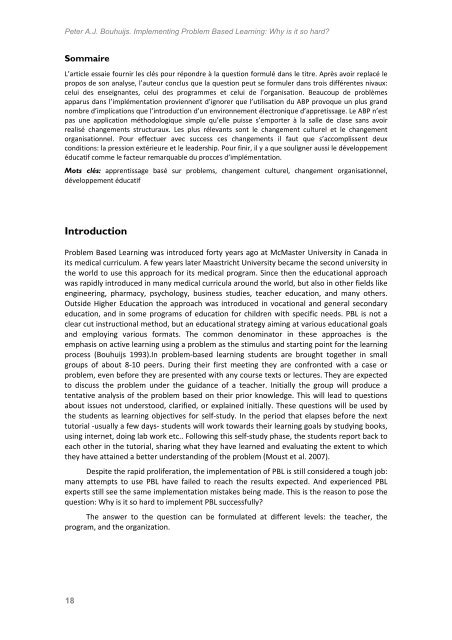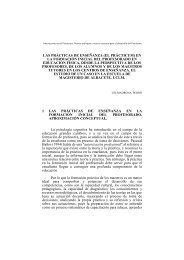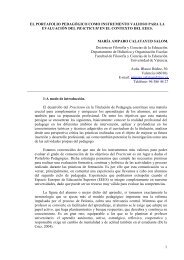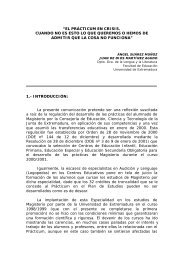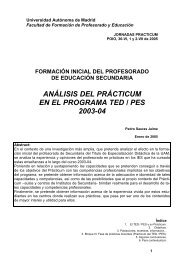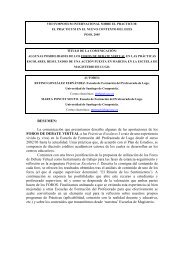descarga completa del vol. 9 nº 1 - REDU. Revista de Docencia ...
descarga completa del vol. 9 nº 1 - REDU. Revista de Docencia ...
descarga completa del vol. 9 nº 1 - REDU. Revista de Docencia ...
You also want an ePaper? Increase the reach of your titles
YUMPU automatically turns print PDFs into web optimized ePapers that Google loves.
Peter A.J. Bouhuijs. Implementing Problem Based Learning: Why is it so hard?SommaireL’article essaie fournir les clés pour répondre à la question formulé dans le titre. Après avoir replacé lepropos <strong>de</strong> son analyse, l’auteur conclus que la question peut se formuler dans trois différentes nivaux:celui <strong>de</strong>s enseignantes, celui <strong>de</strong>s programmes et celui <strong>de</strong> l’organisation. Beaucoup <strong>de</strong> problèmesapparus dans l’implémentation proviennent d’ignorer que l’utilisation du ABP provoque un plus grandnombre d’implications que l’introduction d’un environnement électronique d’appretissage. Le ABP n’estpas une application méthodologique simple qu’elle puisse s’emporter à la salle <strong>de</strong> clase sans avoirrealisé changements structuraux. Les plus rélevants sont le changement culturel et le changementorganisationnel. Pour effectuer avec success ces changements il faut que s’accomplissent <strong>de</strong>uxconditions: la pression extérieure et le lea<strong>de</strong>rship. Pour finir, il y a que souligner aussi le développementéducatif comme le facteur remarquable du procces d’implémentation.Mots clés: apprentissage basé sur problems, changement culturel, changement organisationnel,développement éducatifIntroductionProblem Based Learning was introduced forty years ago at McMaster University in Canada inits medical curriculum. A few years later Maastricht University became the second university inthe world to use this approach for its medical program. Since then the educational approachwas rapidly introduced in many medical curricula around the world, but also in other fields likeengineering, pharmacy, psychology, business studies, teacher education, and many others.Outsi<strong>de</strong> Higher Education the approach was introduced in vocational and general secondaryeducation, and in some programs of education for children with specific needs. PBL is not aclear cut instructional method, but an educational strategy aiming at various educational goalsand employing various formats. The common <strong>de</strong>nominator in these approaches is theemphasis on active learning using a problem as the stimulus and starting point for the learningprocess (Bouhuijs 1993).In problem‐based learning stu<strong>de</strong>nts are brought together in smallgroups of about 8‐10 peers. During their first meeting they are confronted with a case orproblem, even before they are presented with any course texts or lectures. They are expectedto discuss the problem un<strong>de</strong>r the guidance of a teacher. Initially the group will produce atentative analysis of the problem based on their prior knowledge. This will lead to questionsabout issues not un<strong>de</strong>rstood, clarified, or explained initially. These questions will be used bythe stu<strong>de</strong>nts as learning objectives for self‐study. In the period that elapses before the nexttutorial ‐usually a few days‐ stu<strong>de</strong>nts will work towards their learning goals by studying books,using internet, doing lab work etc.. Following this self‐study phase, the stu<strong>de</strong>nts report back toeach other in the tutorial, sharing what they have learned and evaluating the extent to whichthey have attained a better un<strong>de</strong>rstanding of the problem (Moust et al. 2007).Despite the rapid proliferation, the implementation of PBL is still consi<strong>de</strong>red a tough job:many attempts to use PBL have failed to reach the results expected. And experienced PBLexperts still see the same implementation mistakes being ma<strong>de</strong>. This is the reason to pose thequestion: Why is it so hard to implement PBL successfully?The answer to the question can be formulated at different levels: the teacher, theprogram, and the organization.18


